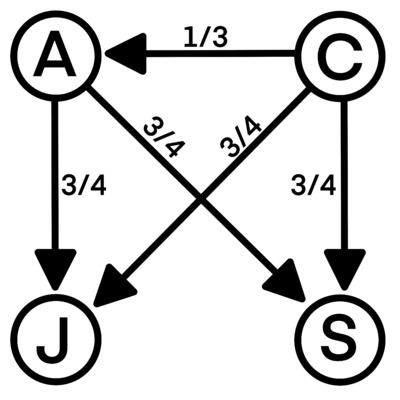2022 AIME II Problems/Problem 2
Problem
Azar, Carl, Jon, and Sergey are the four players left in a singles tennis tournament. They are randomly assigned opponents in the semifinal matches, and the winners of those matches play each other in the final match to determine the winner of the tournament. When Azar plays Carl, Azar will win the match with probability ![]() . When either Azar or Carl plays either Jon or Sergey, Azar or Carl will win the match with probability
. When either Azar or Carl plays either Jon or Sergey, Azar or Carl will win the match with probability ![]() . Assume that outcomes of different matches are independent. The probability that Carl will win the tournament is
. Assume that outcomes of different matches are independent. The probability that Carl will win the tournament is ![]() , where
, where ![]() and
and ![]() are relatively prime positive integers. Find
are relatively prime positive integers. Find ![]() .
.
Solution 1
Let ![]() be Azar,
be Azar, ![]() be Carl,
be Carl, ![]() be Jon, and
be Jon, and ![]() be Sergey. The
be Sergey. The ![]() circles represent the
circles represent the ![]() players, and the arrow is from the winner to the loser with the winning probability as the label.
players, and the arrow is from the winner to the loser with the winning probability as the label.
This problem can be solved by using ![]() cases.
cases.
![]()
![]() 's opponent for the semifinal is
's opponent for the semifinal is ![]()
The probability ![]() 's opponent is
's opponent is ![]() is
is ![]() . Therefore the probability
. Therefore the probability ![]() wins the semifinal in this case is
wins the semifinal in this case is ![]() . The other semifinal game is played between
. The other semifinal game is played between ![]() and
and ![]() , it doesn't matter who wins because
, it doesn't matter who wins because ![]() has the same probability of winning either one. The probability of
has the same probability of winning either one. The probability of ![]() winning in the final is
winning in the final is ![]() , so the probability of
, so the probability of ![]() winning the tournament in case 1 is
winning the tournament in case 1 is ![]()
![]()
![]() 's opponent for the semifinal is
's opponent for the semifinal is ![]() or
or ![]()
It doesn't matter if ![]() 's opponent is
's opponent is ![]() or
or ![]() because
because ![]() has the same probability of winning either one. The probability
has the same probability of winning either one. The probability ![]() 's opponent is
's opponent is ![]() or
or ![]() is
is ![]() . Therefore the probability
. Therefore the probability ![]() wins the semifinal in this case is
wins the semifinal in this case is ![]() . The other semifinal game is played between
. The other semifinal game is played between ![]() and
and ![]() or
or ![]() . In this case it matters who wins in the other semifinal game because the probability of
. In this case it matters who wins in the other semifinal game because the probability of ![]() winning
winning ![]() and
and ![]() or
or ![]() is different.
is different.
![]()
![]() 's opponent for the final is
's opponent for the final is ![]()
For this to happen, ![]() must have won
must have won ![]() or
or ![]() in the semifinal, the probability is
in the semifinal, the probability is ![]() . Therefore, the probability that
. Therefore, the probability that ![]() won
won ![]() in the final is
in the final is ![]() .
.
![]()
![]() 's opponent for the final is
's opponent for the final is ![]() or
or ![]()
For this to happen, ![]() or
or ![]() must have won
must have won ![]() in the semifinal, the probability is
in the semifinal, the probability is ![]() . Therefore, the probability that
. Therefore, the probability that ![]() won
won ![]() or
or ![]() in the final is
in the final is ![]() .
.
In Case 2 the probability of ![]() winning the tournament is
winning the tournament is ![]()
Adding case 1 and case 2 together we get ![]() . So the answer is
. So the answer is ![]()
Video Solution (Mathematical Dexterity)
https://www.youtube.com/watch?v=C14f91P2pYc
See Also
| 2022 AIME II (Problems • Answer Key • Resources) | ||
| Preceded by Problem 1 |
Followed by Problem 3 | |
| 1 • 2 • 3 • 4 • 5 • 6 • 7 • 8 • 9 • 10 • 11 • 12 • 13 • 14 • 15 | ||
| All AIME Problems and Solutions | ||
The problems on this page are copyrighted by the Mathematical Association of America's American Mathematics Competitions. 










